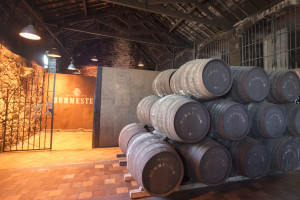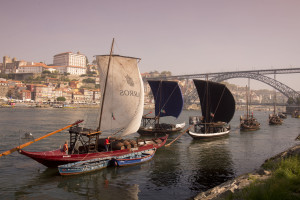Today we have a guest post from Paul Wagner, who tells us what to expect at the session entitled “A Short History of Time in a Glass: Colheita Ports over 50 Years” at this year’s SWE Conference in Washington DC. It sounds fantastic!
The vast ancient cellar in Oporto was full of barrels marching off into the shadows, each covered with the light dust that had gently accumulated over decades of aging. As my eyes adjusted to the dim light, I began to make out chalk marks on the barrel heads: 1997, 1983, 1957, 1966, 1934, the list went on and on, as did the cellar. I wandered around for a few minutes. There seemed to be thousands of barrels here. And at least one of those barrels had the date 1952: the year I was born.
What wine lover’s heart wouldn’t quicken with that experience?
And yet these wines are rarely mentioned by wine experts. Very few people—even wine experts—have tasted through these wines in any kind of depth; and a comprehensive tasting of these wines is simply not available via a single winery.
But at this year’s SWE national conference, the wineries of Sogevinus: Kopke, Barros, Burmester and Calem, will provide a stunning tasting of Colheita Ports going back more than fifty years. They have the largest inventory of Colheita Ports in the world.
It is an experience not to be missed.
Let’s put these wines into context and perspective: there are basically two kinds of Port: Ruby and Tawny. (We won’t mention white Port here, because it’s similar but made with white grapes.)
Both Ruby and Tawny Ports share the same classic grape varietals: Touriga Nacional, Touriga Frances, Tinta Roriz, Tinto Cao, Tinta Barroca, and a few others. It’s once the grapes are picked that the difference between Ruby and Tawny begins to become clear.
Ruby Ports are focused on fruit. As young wines they spend little time in barrel, and are bottled quickly and released in time to capture their lively, fruity character. Basic Ruby Ports are a blend of vintages, but the very best Ruby Ports are deeply concentrated wines that can age for decades. They are identified early in their lives, kept as separate lots by vintage, and released as Vintage Port. Only a few years in each decade are good enough to make Vintage Port.
Tawny Ports, on the other hand, are focused on complexity. These are wines that spend their lives not in the bottle, but in barrel. The simpler Tawny Ports are blended and released at three years of age. Then come the more interesting wines: Tawny Ports “with an indication of age” that can be ten, twenty, thirty, and even forty years old.
And the greatest of all Tawny Ports are the Colheita Ports: Tawny Ports that are not blended, but come from a single harvest (which is what Colheita means in Portuguese) and have been aged in barrel at the winery ever since. And they can live longer than you or I. There is something inexplicably seductive about walking through a cellar full of barrels of Colheita Ports.
And while Ruby Ports provide rich fruit flavors, Tawny Ports give us an incredible depth of complexity, where the fruit fades back to blend in with notes of caramel, vanilla, dried apricots, toffee, cinnamon, tea, almonds, dates, hazelnuts,…the list is endless and enchanting.
While Ruby and Vintage Ports should be consumed within a few days of opening, to capture the fruit in the wine, Tawny Ports can live a few weeks after the bottle has been opened. This makes them much more successful as wines in a restaurant setting, and even at home. It’s a rare couple that can finish off a bottle of Vintage Port over two or three days. But a bottle of Colheita from the year of their wedding can be enjoyed over the course of a few weeks of memorable dinners.
And while other Ports are bottled in a modern bottling line, Colheita Ports are usually hand bottled in the Port houses of Vila Nova da Gaia—each bottle hand-filled, hand-corked, hand-labelled, and carefully hand-dipped in wax for the capsule. And each is then hand-stenciled with a white painted label as well.
At this year’s conference, Tania Oliveira will lead a tasting of Colheita Ports from the wineries in the Sogevinus Portfolio. She is a gifted speaker with great charm and a collection of older Colheita Ports that will take your breath away. And one of her wines just might be from the year of your birth. Tania’s session will be held on Thursday, August 11 at 3:pm, as part of SWE’s 40th Annual Conference.



